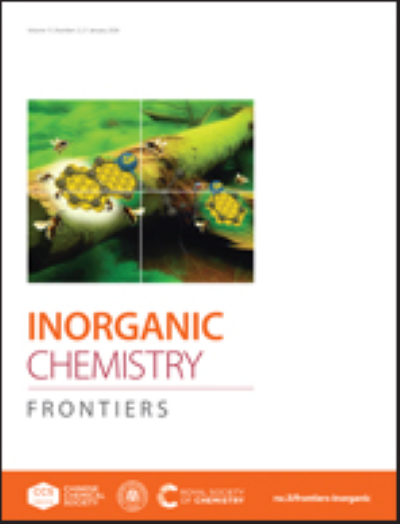Design of DyIII single-molecule magnets with molecularly installed luminescent thermometers based on bridging [PtII(CN)2(C^N)]– complexes
IF 6.1
1区 化学
Q1 CHEMISTRY, INORGANIC & NUCLEAR
引用次数: 0
Abstract
Luminescent Single-Molecule Magnets (SMMs) gained broad scientific attention due to potential applications in dual sensing of temperature and magnetic field or optical thermometry for the self-monitoring of temperature in SMM-based devices. We present a route toward thermoresponsive emissive SMMs based on linking two molecular components separately providing luminescent thermometry and SMM features. We combined Dy(III) centers of a rationally constrained coordination sphere giving tunable magnetic anisotropy with an emissive dicyanido(2-phenylpyridinato)platinate(II) anion, [PtII(CN)2(ppy)]– exhibiting ratiometric optical thermometry. These molecular precursors undergo the self-assembly into {[DyIII(MeOH)2(NO3)]2[PtII(CN)2(ppy)]4}∙n(solvent) (1) coordination chains of a weak field-induced SMM behavior. However, upon exchange of MeOH molecules, axially aligned within eight-coordinated Dy(III) complexes, by O-donor organic ligands, including 4(1H)-pyridone (2), pyridazin-4(1H)-one (3), and N-methyl-pyridin-4(1H)-one (4), an improvement of SMM character was achieved. This is accompanied by the tuning of optical thermometry related to temperature-variable excitation and emission spectra of Pt(II) complexes which leads to the best-performance multifunctionality in a 4(1H)-pyridone-containing compound. Our work proves that a heterometallic synthetic approach provides a unique class of SMM-based luminescent thermometers where lanthanide-centered magnetism will not be affected by the light employed to monitor the temperature through an optical process occurring in attached cyanido transition metal complexes.基于桥接 [PtII(CN)2(C^N)]-配合物设计带有分子安装的发光温度计的 DyIII 单分子磁体
发光单分子磁体(SMM)因其在温度和磁场双重传感或基于 SMM 器件的温度自监测光学测温方面的潜在应用而受到科学界的广泛关注。我们提出了一条通向热致发射型 SMM 的途径,其基础是将两种分子成分连接起来,分别提供发光测温和 SMM 功能。我们将具有可调磁各向异性的合理约束配位球的镝(III)中心与具有发射性的二氰基(2-苯基吡啶)铂(II)阴离子[PtII(CN)2(ppy)]-结合在一起,显示出比率光学测温功能。这些分子前体自组装成{[DyIII(MeOH)2(NO3)]2[PtII(CN)2(ppy)]4}-n(溶剂) (1) 配位链,具有弱场诱导的 SMM 行为。然而,在将八配位 Dy(III) 复合物中轴向排列的 MeOH 分子与 O-供体有机配体(包括 4(1H)-吡啶酮 (2)、哒嗪-4(1H)-酮 (3) 和 N-甲基吡啶-4(1H)-酮 (4))交换后,SMM 特性得到了改善。与此同时,我们还调整了铂(II)配合物与温度可变的激发光谱和发射光谱相关的光学测温,从而在含 4(1H)-吡啶酮的化合物中实现了最佳性能的多功能性。我们的工作证明,异金属合成方法提供了一类独特的基于 SMM 的发光温度计,通过附着在氰基过渡金属复合物中的光学过程,以镧为中心的磁性不会受到用于监测温度的光的影响。
本文章由计算机程序翻译,如有差异,请以英文原文为准。
求助全文
约1分钟内获得全文
求助全文
来源期刊

Inorganic Chemistry Frontiers
CHEMISTRY, INORGANIC & NUCLEAR-
CiteScore
10.40
自引率
7.10%
发文量
587
审稿时长
1.2 months
期刊介绍:
The international, high quality journal for interdisciplinary research between inorganic chemistry and related subjects
 求助内容:
求助内容: 应助结果提醒方式:
应助结果提醒方式:


